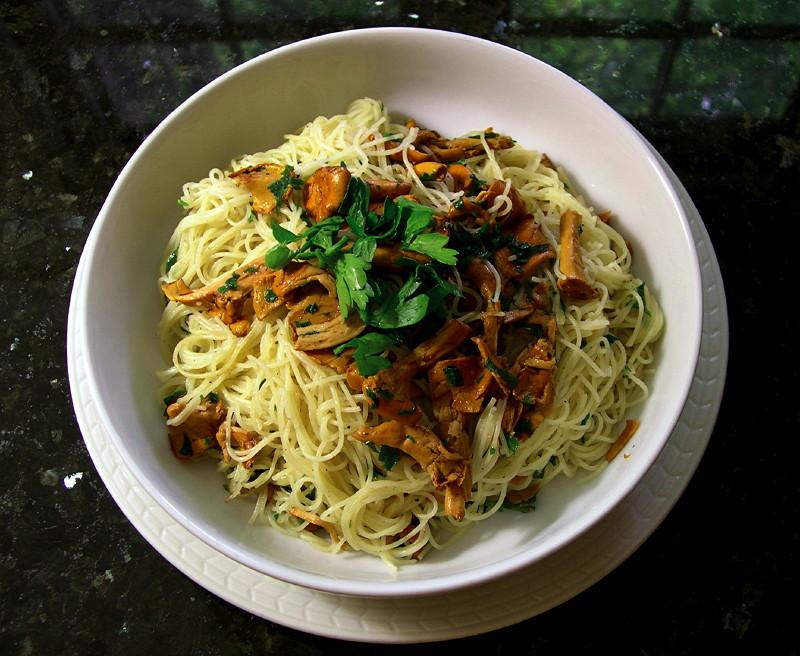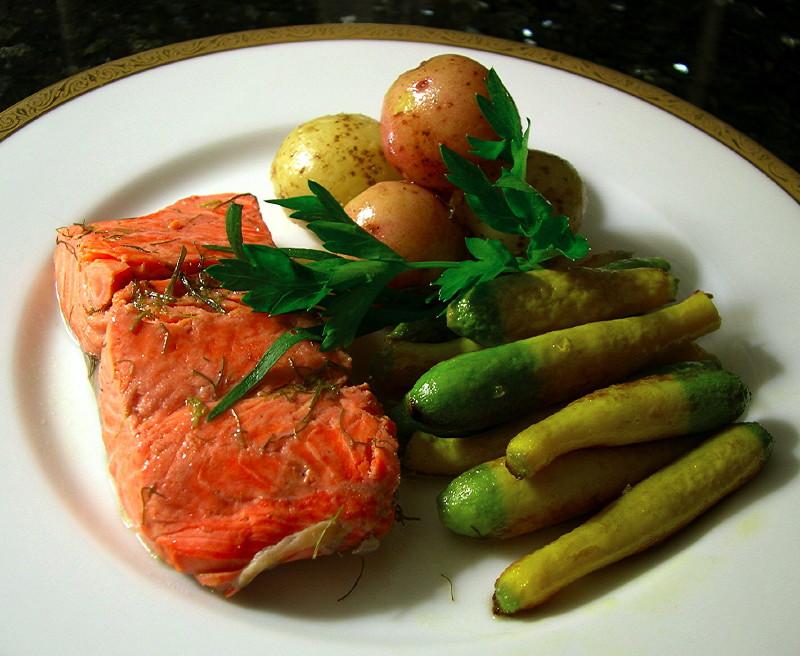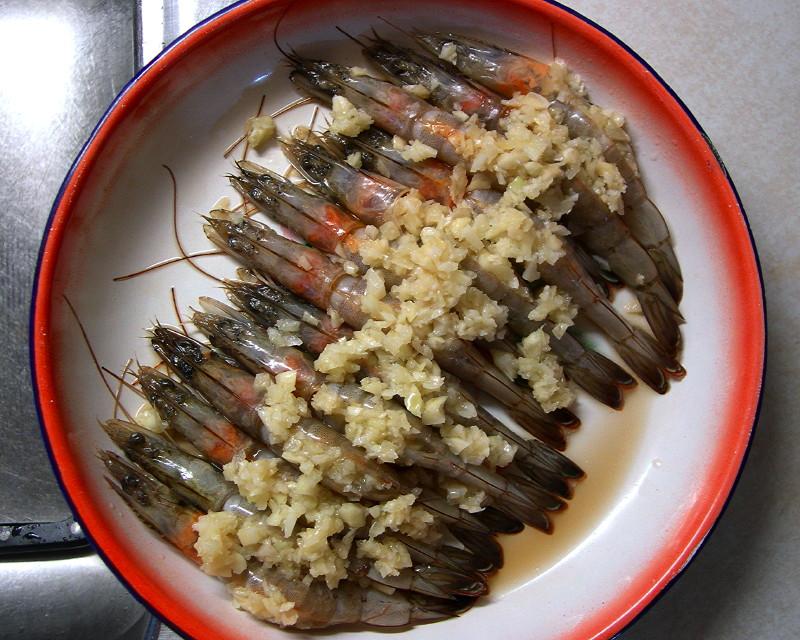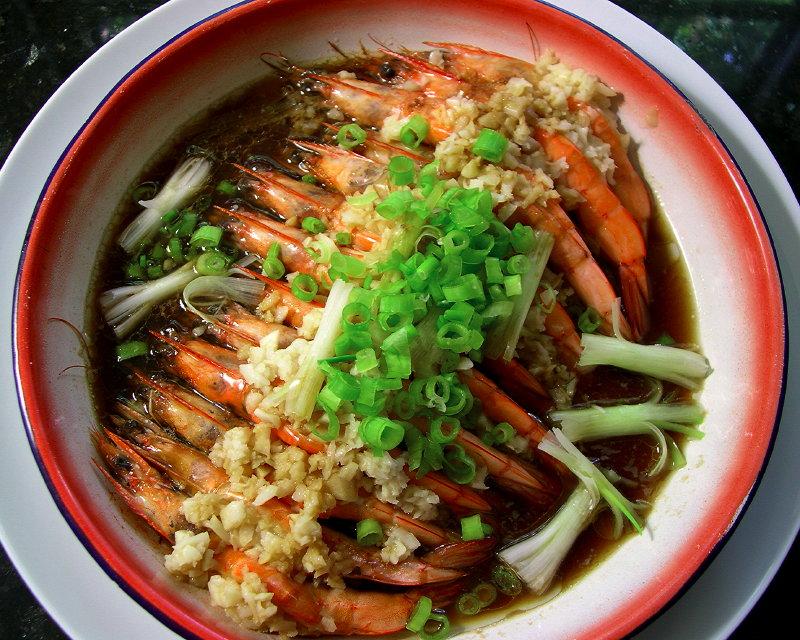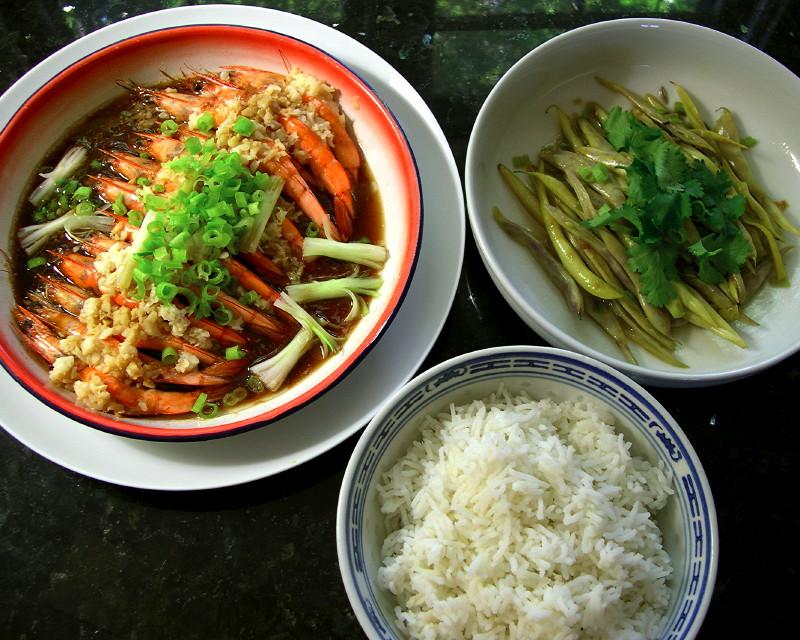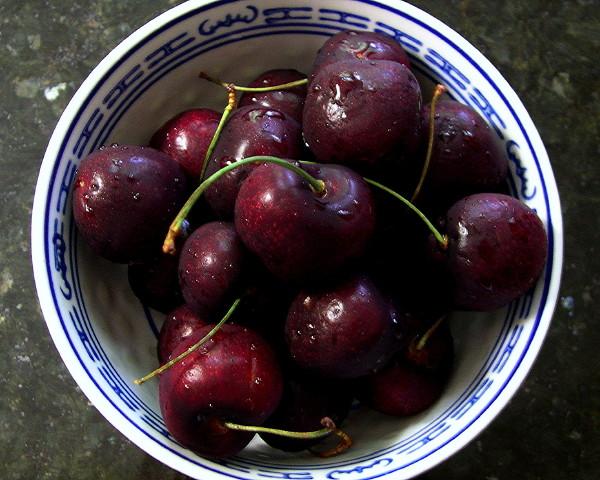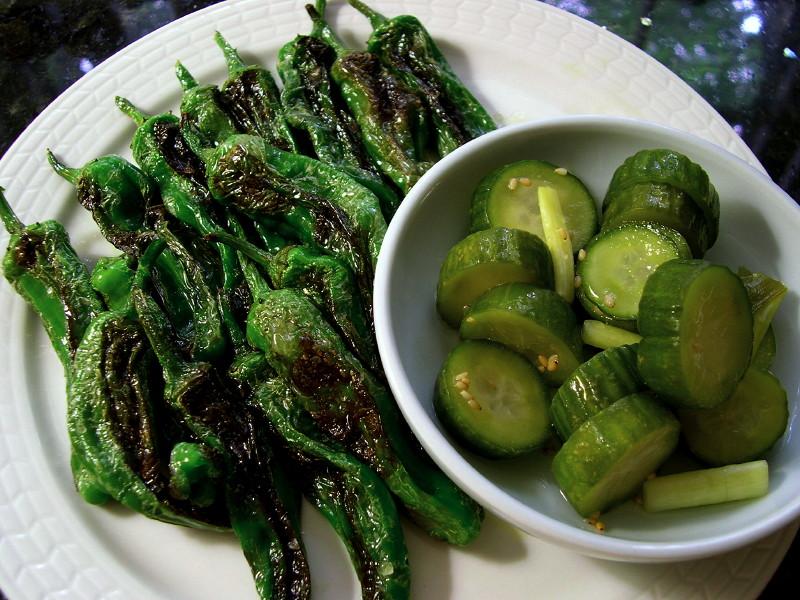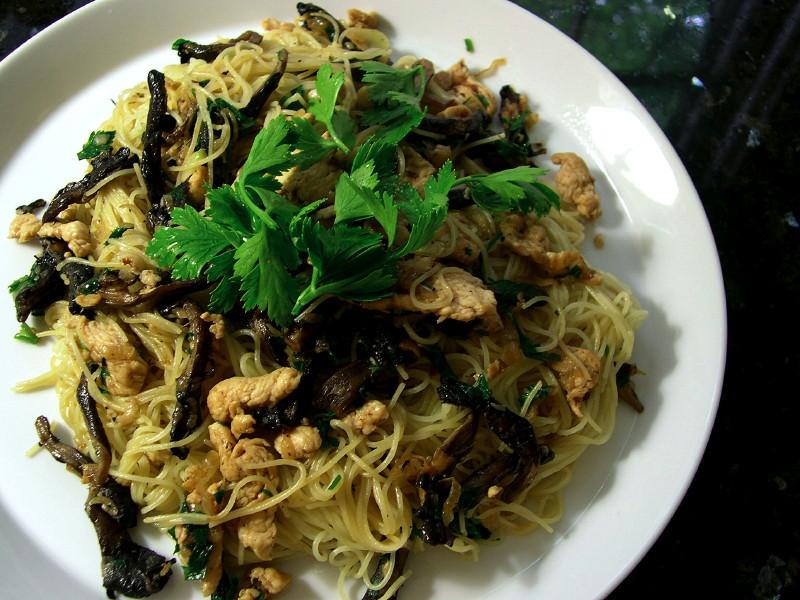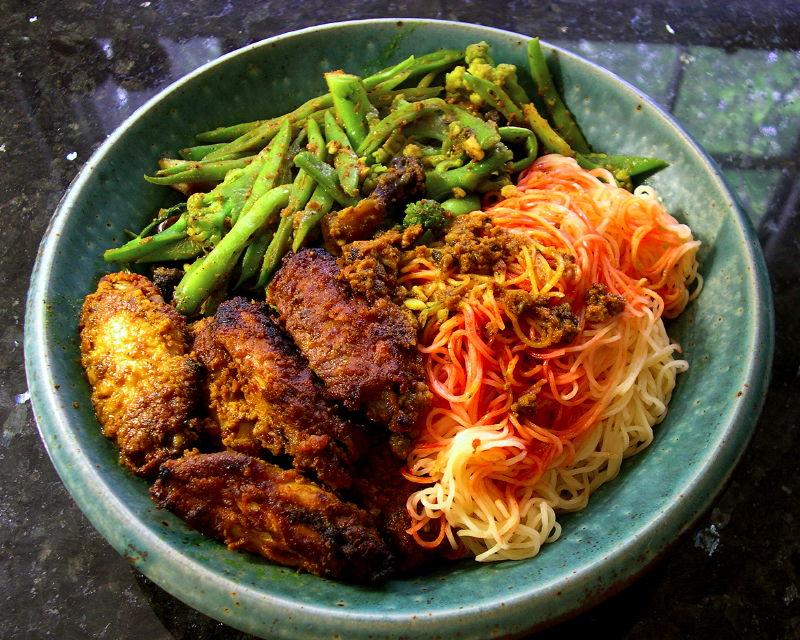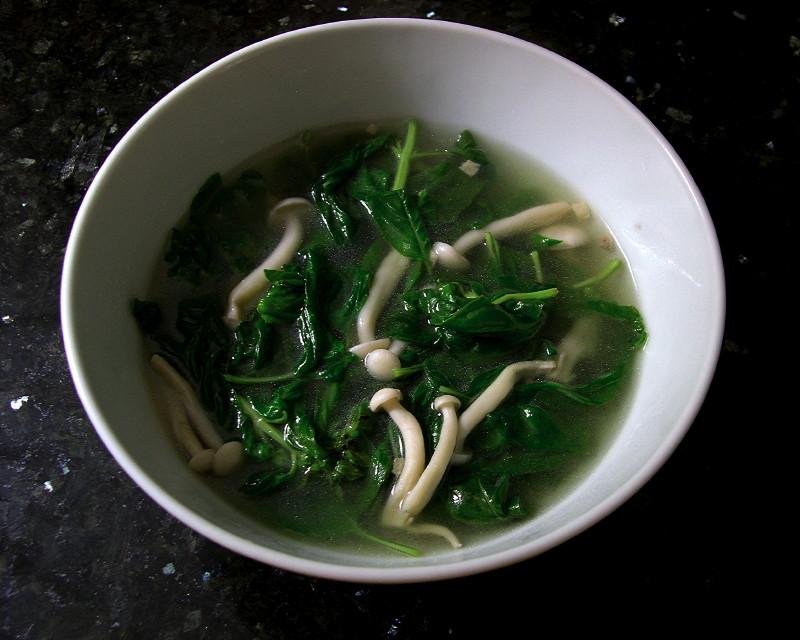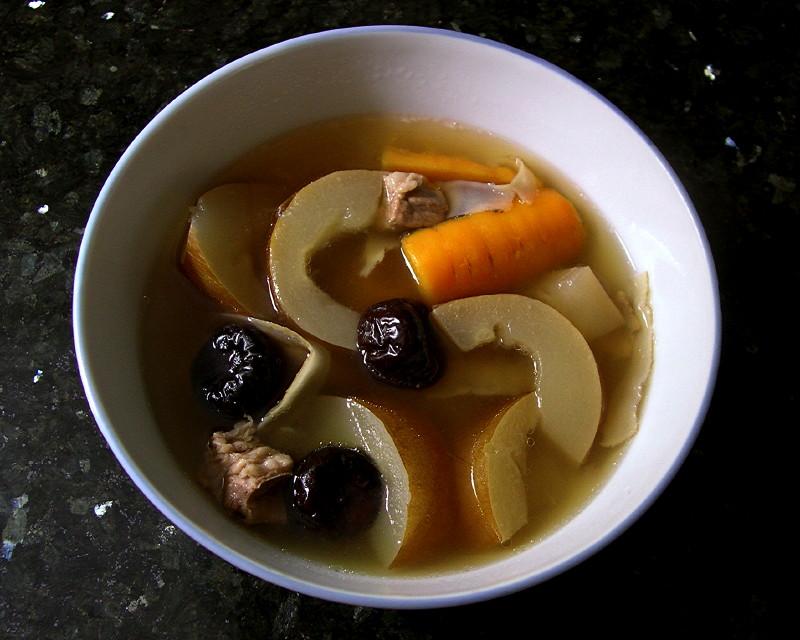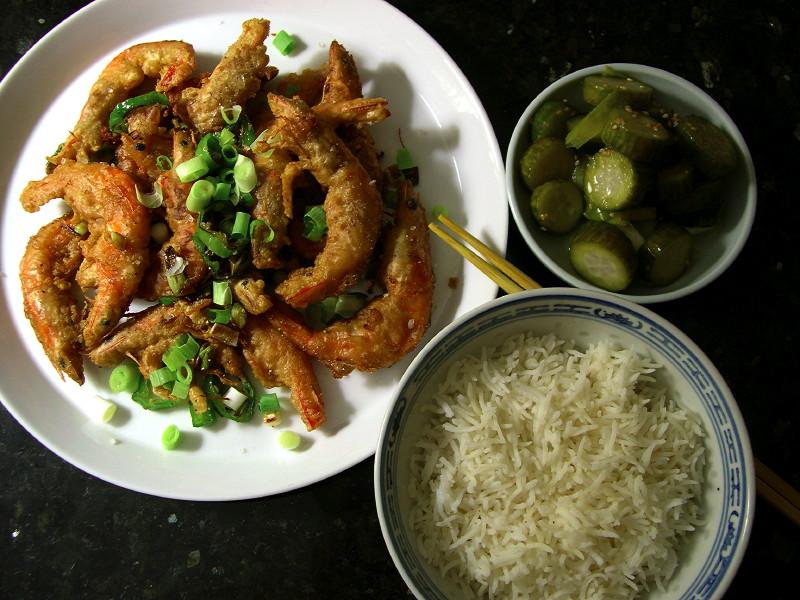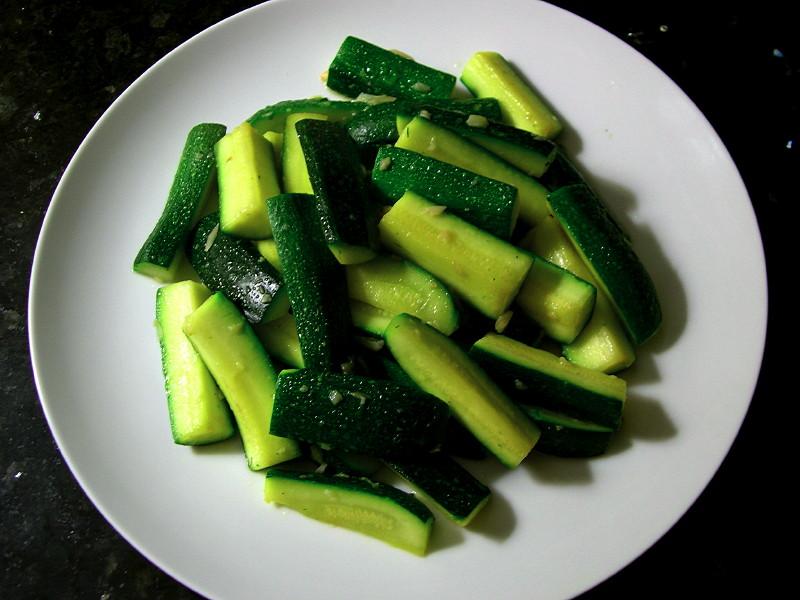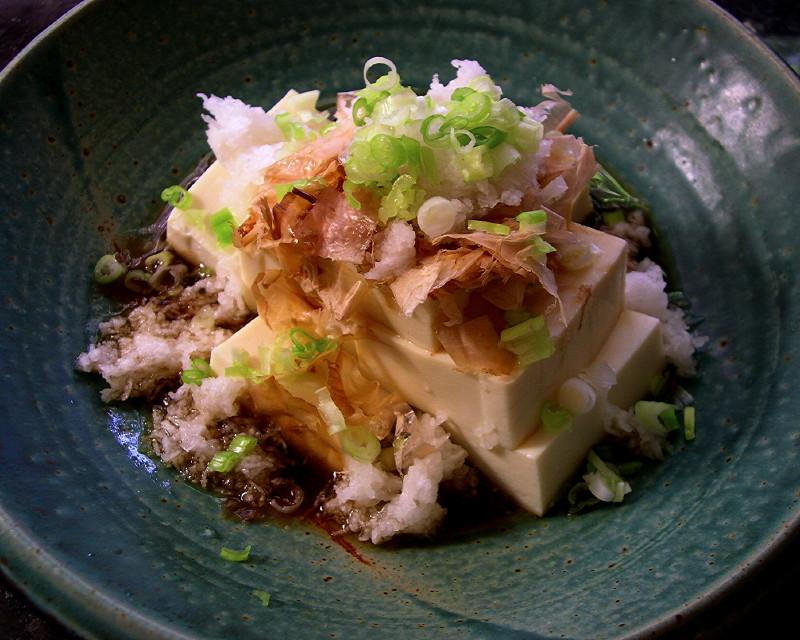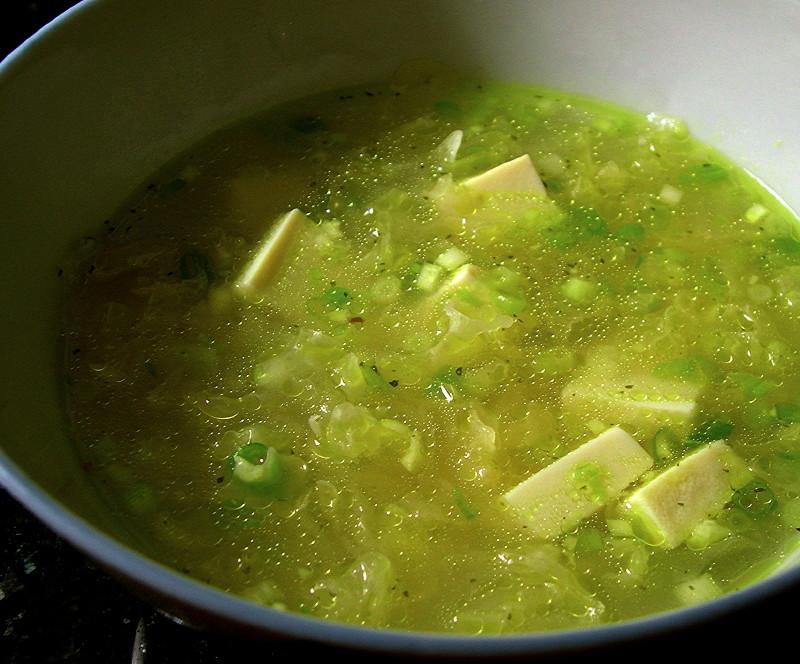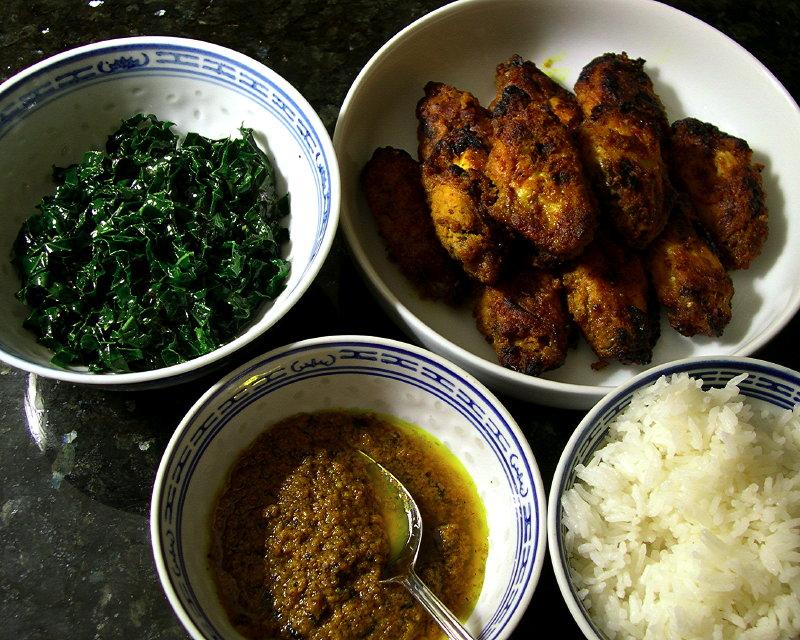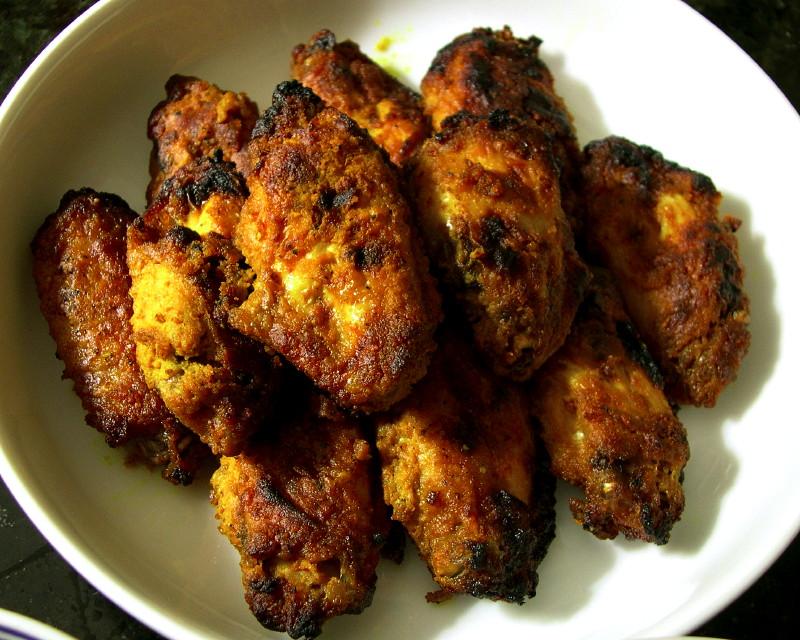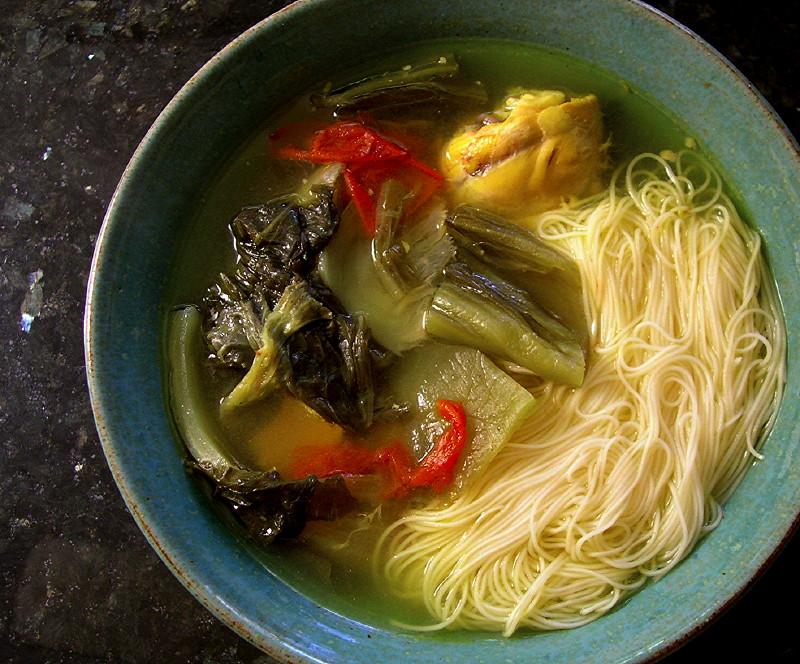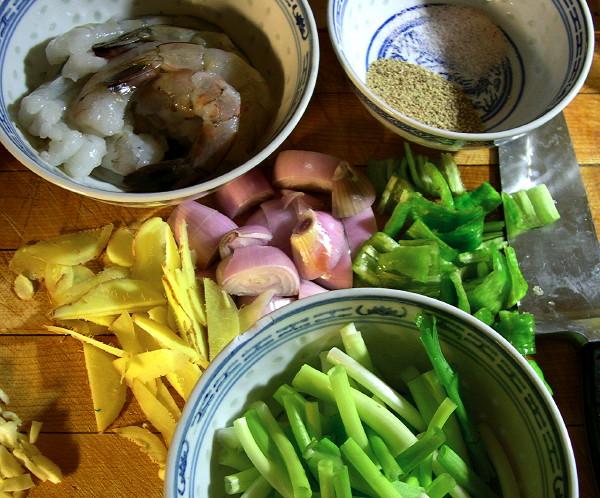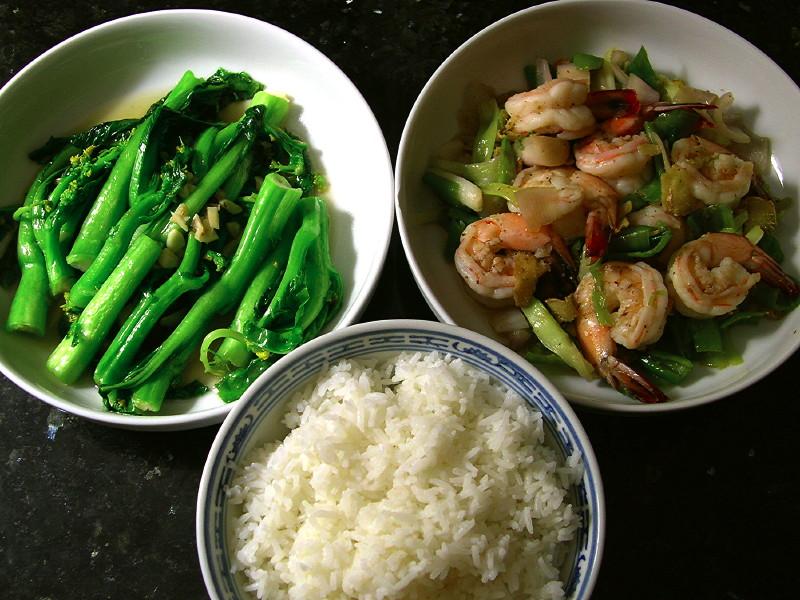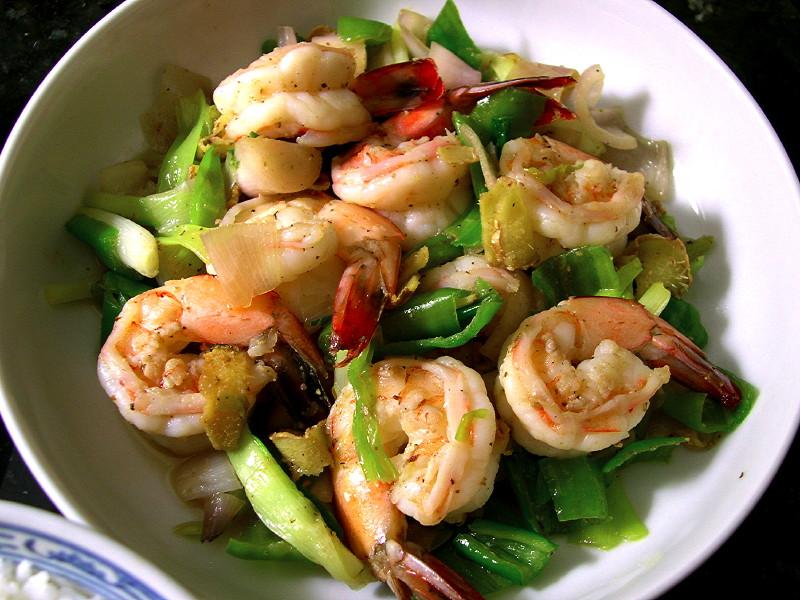-
Posts
3,810 -
Joined
-
Last visited
Content Type
Profiles
Forums
Store
Help Articles
Everything posted by huiray
-
This post and those responding to/arising from it have been moved from another discussion, as they are more relevant here. Huh. I've done what Pepin showed for years without ever seeing it on Pepin's show or even knowing that Pepin showed it. However, I only do a single cut through the leek (to give a "halved-but-connected" leek) through the wider part of the leek, i.e. in the plane of the axis of the speading leaves, then separating the leaves/bracts as needed under the tap. I never needed to separate more than 4-5 levels from the outside to get all the grit out. Perhaps I'm wrong, but it seems to me that it is simply logical to do what Pepin showed - without needing to have Pepin show you what to do. At other times I simply remove the outermost leaves entirely then slit the inner leaves along the "rib" only as far as needed to check for grit. I have never found it necessary to go inwards more than 4-5 "levels"; I've never found grit in the interior of the leaf bundle. Of course, it helps to select "clean" looking tightly wrapped leeks in the first place. These "more intact" leeks are nice for buttered leeks, say, or slicing into whole "rounds" (maybe 1-inch "thick") and sautéed/browned on the ends. FWIW I think Pepin is a nice guy and a good French chef but I hardly think of him (or Julia Child, for that matter) as Divine Personages. In fact, I barely think of him at all. But, of course, to each his/her own; diff'rent strokes for diff'rent folks, etc etc.
-
• Chanterelles, parsley, butter, salt, angel hair pasta. Later on: • Sockeye salmon, poached in Riesling w/ parsley, fennel & tarragon. (and salt) • Baby new potatoes, boiled & buttered. • Baby Zephyr squash, sautéed.
-
Here's what I observed on one occasion I was at a certain restaurant in Frederick, MD where they serve a 21-course tasting menu... A couple who came in and waited for the Table (I asked) spent ALL THE TIME on their smart phones. They didn't even talk to each other. I got seated next to the husband of the pair at the 8-seater special table for this tasting menu. I tried to engage him in conversation. No response, his body language told me to fuck off while he busied himself with his phone. His wife did the same. (BTW they both barely ate anything, leaving many plates barely touched. I got the distinct impression they were there as a mark of "having been there", not to actually enjoy any of the food. I managed to ask the wife why she left almost all of a plate behind and she said she didn't care for the food on the plate) Another couple who got the seats closest to the kitchen (it may be helpful if you knew the layout of this particular table, if you know which one I mean - the wife had a HONKING big SLR camera ON A TRIPOD which she used to take photos of the dishes as they were served. On my left were three women, the one on my immediate left did make small talk with me but she did take photos of each dish albeit fairly discreetly with a Samsung smart phone. At the end of the meal half of the folks at the Table had no idea what was supposed to occur - and I had to stop another pair from just walking off until I could get the staff to get the menus to the folks at the table. (A complimentary menu of what was served that night is given to diners). There was little sense that they had eaten a nice meal, except for the three women on my left (as mentioned above) who enjoyed the food as much as I did; the others seemed to be just "scoring another notch".
-
Smithy, thanks for the kind words. I appreciate them. The hot-oil garlic technique in this case was, yes, to lightly cook them - taking the "rawness" off them, as the short steaming period would not have been enough to "cook" otherwise raw garlic. Also, it served to infuse the oil to generate "garlic oil". (I also macerated them, with the spoon, to add to the infusion into the oil) Yes, it could have been done in a pan as well. No, "overcooking them" was not really an issue here although doing it in the pan does run that risk. However, generating lightly colored/browned garlic by doing so and then using it in this dish is also an alternative. The flavor profile of the garlic changes with the hot oil treatment or with a sauté in a pan, of course; what I wanted was less of the "raw" taste. BTW, this technique of hot oil poured over something is also used in generating the ginger-scallion sauce I make for Hainanese Chicken, a known method. The results are fairly different between doing so and just steeping the grated/minced ginger & scallion in cold oil for a while, which is the alternative. I far prefer the use of the hot oil, which also produces a more "macerated"/softened ginger-scallion mix with attendant change in the flavor profile.
-
Kim Shook, I'm not sure I can answer your question properly... The shrimp were just battered and deep fried in vegetable oil. They were battered a bit heavily, yes, but I wanted to try to keep a bit more batter between the heads and the bodies to try to stem seeping of head cream from some of them (noticed after the first few went into the oil). The batter was a 2 AP flour : 1 corn starch : 2 water mix with a bit of baking soda, some vegetable oil, an egg white and a bit of salt. After deep frying and draining they were tossed in the pan w/ the scallions and chillies being sautéed/"stir-fried" with oil (plus salt & pepper) - so they get a fresh slight sheen of oil, maybe that is what you are thinking of?
-
Lunch today. • Pacific White Shrimp [farmed; Bedrock Springs, IN] - backs slit & deveined but otherwise left all intact; marinated in Shaoxing cooking wine (about an hour); drained and the slits stuffed w/ chopped garlic¶ & garlic oil, with garlic+oil strewn over them (in an enameled metal dish) as well. Steamed for just a few minutes with "scallion flowers" added a minute before the shrimp were just done. Dressed w/ a mixture of good soy sauce [Higeta Honzen] and black sesame oil, plus chopped green parts of scallions. ¶Fresh Music garlic, BIG head; about a head's worth; almost-smoking vegetable oil was poured onto and over the chopped garlic in a pyrex cup, the mixture stirred and left for a short while to cool open to the air. • Dragon Tongue beans & Yellow Wax beans, sliced diagonally; sautéed w/ "scallion oil" (chopped white parts of scallions sautéed in hot vegetable oil; the scallion parts left in and the beans added etc) & sea salt. • White rice. Dessert: These were pretty big and fat ones. :-)
-
Couple of lunches from days past. ---------------------------------- • Shishito peppers, pan-seared w/ sea salt & a little hot oil. Pickled scallions & Japanese cucumbers. • Angel hair pasta tossed in the pan w/ sautéed sliced chicken breast, cut-up black-tinged maitake mushroom (some pieces were tough; those were tossed during eating), chopped smashed garlic, chopped parsley. Seasoning adjusted. Coriander leaves garnish. ----------------------------------- • Leftover broiled turmeric chicken wings. • Roma beans (sliced diagonally) pan-cooked/fried w/ the leftover turmeric chicken wings pan-deglazing-sauce plus some extra oil. • Skinny wonton noodles (commercial). Folks interested in chemistry might note that the turmeric stained the wonton noodles red where it came in contact with it. The curcuminoids in turmeric are acid-base indicators and the red color on the noodles attests to their being still alkaline due to the use of "kan sui" (alkali water/K2CO3-NaHCO3) in making them.
-
Soup. Basil (used as a vegetable) & white beech mushrooms in chicken stock with some chopped-up pieces of chicken fat added in and rendered in the soup.
-
STELLAR recipes is in the mouth of the chomper, no? What is delicious to one is poison to another. OK, since you say you like the bitterness - then how do you decide something is too bitter? Before cooking? After cooking? Or do you try a slice raw? If it is "after cooking" it would be too late to do anything about it; whereas if one messed with it before cooking it might then turn out too tame if the uncooked gourd was only mildly bitter to start with... Apart from blanching it (as dcarch mentioned) you can also toss it (sliced up & deseeded) with salt, let sit for a while, rinse and pat dry. I dislike this (even if I did want to reduce the bitterness, which I have never found to be needed) because it makes the slices limp. Some recipes (by no means exhaustive) to consider, depending on one's notion of STELLAR... Yong Tau Foo Bittergourd (BG) with beef and LOTS of chopped smashed garlic (I dislike anything else in this except just salt) (NO oyster sauce, onion or ginger...personally) BG omelette (this is NOT the same as the Okinawan dish you mentioned), Cantonese/Hokkien variations BG with pork spare ribs & black bean sauce BG stuffed w/ pork & prawn BG soups of various kinds (e.g. the pork&prawn stuffed BG can also be cooked as a soup) etc
-
p.s. I would mention that of the Heritage series, the Cantonese and Teochew ones are probably the ones with the least "Malaysian"/("Singaporean") influence, and many (if not most) of the recipes could be read as simply Chinese recipes, but as practiced in Malaysia & Singapore, with use of local ingredients as appropriate (e.g. local fishes) and with some local color.
-
Try these for starters. The Epigram "Heritage Cookbook Series" - "madam choy's cantonese recipes", "madam krishnan's south indian recipes", "uncle lau's teochew recipes", "irene's peranakan recipes", "robin's eurasian recipes". (Yes, the book titles use all lower case letters as printed on the covers) You can get these via Amazon. "nonya flavours: A complete guide to Penang Straits Chinese Cuisine". You can get this in the USA via Abe Books [which is actually a Canadian organization], amongst other sources. (I got my copy from the Penang Bookshelf via Abe Books) "The Hakka Cookbook: Chinese Soul Food from around the World" (Anusassananan) has a useful section (IMO) on dishes found in Malaysia & Singapore in the Hakka tradition. Available via Amazon. In case you are wondering, "Malaysian" (the nationality) does NOT equal "Malay" (the ethnicity). "Malaysian Cuisine" encompasses the melting pot of Chinese/Indian/European/general SE Asian/British (because of its colonial past)** as well as Malay/Indonesian/etc influences and different cuisines, not just Malay cuisine. If you are specifically looking for MALAY cuisine, there are cookbooks for that too. I don't really have recommendations for that, however; and I suspect the classical ones would be in Malay, not English. Peranakan cuisine, however, is heavily influenced by Malay cuisine, as one might expect from the history of the culture & community. But perhaps you know all this already. If so, then please disregard the last paragraph. :-) ** An example of a classic Malaysian dish with British Colonial origins is 'Hainanese Pork Chop'. Google it. ;-)
-
• Cucumber soup. Short-cut pork spare ribs (parboiled first), water, dried cuttlefish, Chinese jujubes (variety from Shandong), honey jujubes, dried Solomon’s Seal rhizome slices (玉竹), sea salt, sliced Russian yellow (Brown Russian) cucumber (deseeded), carrot (quartered). Slow simmer for about 1½ -2 hours. • Salt and Pepper shrimp. Pacific White Shrimp, seasoned batter; deep-fried. Hot oil, chopped scallions, sliced long hot green chillies, fried shrimp, salt & white pepper. • White rice. • Pickled scallions & Japanese cucumbers.
-
One of the simplest zucchini dishes but one of the most satisfying to me. Zucchini simply sautéed with LOTS of garlic (I used about half a head for 5 medium zucchinis) and sea salt. About half of the stuff plated, plenty of garlic beneath the zucchini slices. I had this for dinner w/ more freshly broiled turmeric chicken wings (last of the marinated wings from the fridge) and white rice.
-
Groceries 2014-0718 to 0719 Goose the Market: Locally farmed Pacific White shrimp (whole, heads & everything) [bedrock Springs, Crawfordsville, IN]; Wild Alaskan king salmon; Cheeses – Bellavitano Balsamic [sartori], Quadrello di Bufala [Portoni], Brescianella Stagionata [Guffanti]. BRFM: • Silverthorn Farm – Orange carrots, fennel bulb, shishito peppers, baby Zephyr squash, baby Red Gold potatoes, Tuscan kale, basil (lots, for pesto). • Annabelle’s Garden – Cherokee Purple tomatoes. • Whipker-Azalia Farm Market – Baby zucchini w/ blossoms. • Wild’s Apple Farm – Russian Yellow cucumber (big one, for soup). • Schacht Farm – Eggs. • Brotgarten – “Epi wheat stalk” bread loaf. CFM: • Farming Engineers – Dragon Tongue beans, Yellow wax beans. • Daily Farms – Chanterelle mushrooms. • Middlefork Produce – Spanish Roja garlic (stocked up on these too). • Van Antwerp’s farm Market – Green zucchini (9/$3), Honeydew melon “Marygold”. Om India Plaza: Basmati rice – Daawat & Qilla brands; Murraya koenigii leaves (curry leaves, கருவேப்பிலை), drumsticks (Moringa oleifera immature fruits), guva beans, coriander leaves; fresh samosas. Saraga International Market: Bone-in beef short ribs ($3.69/lb), bone-in sliced beef shanks ($2.29/lb), fuzzy squash, bittergourds, poblano peppers, green onions/scallions (3/$1), limes (10/$1); fresh enoki, king oyster & white beech mushrooms.
-
There is no need to look down haughtily on store-bought foodstuffs. They're fine, so long as one gets the decent ones. Even the mediocre ones or even the - gasp! - processed stuff like American cheese are savored and desired by top-line chefs and fine dining chefs. Similarly for ramen packs and instant ramen or "fresh ramen" (but store-bought). They're fine for what they are. I enjoy them and make no apologies for devouring them. Gussy them up with fresh vegetables, meats, eggs, whatnot - and one has a very nice bowl of tasty soupy noodles. Yes, the seasoning packet included is used too. There are all sorts of varieties and brands and producers ranging across large swaths of E and SE Asia. Some of them are very, very good indeed, and better than what one could make at home from scratch in many cases. So - ramen burgers, etc --- take them for what they are, things to be savored on their own terms. Wylie Dufresne comment/quote from that NYT article: " Besides, said Wylie Dufresne, the chef at WD-50 in New York: “It’s actually a fuller life to try all that stuff. I would rather not be pious about things.” "
-
Tarentaise, Balsamic Bellavitano, crackers.
-
A leisurely dinner in a few stages over several hours. • Hiyayakko. Soft tofu blocks, with dipping sauce,¶ Katsuobushi, shaved/grated daikon, chopped scallions. ¶Hokkaido Kelp Flavor naturally brewed soy sauce [Wei Chuan] diluted w/ water, Hondashi flakes stirred in, then hon-Mirin [Takara] added and the mixture zapped in the microwave for ½ a minute. • Soup. Sliced garlic, oil, chicken stock, snow fungus (rehydrated), chopped scallions, tofu chunks. • Broiled turmeric chicken wings.§ • Tuscan kale (de-ribbed, chiffonaded) “stir-fried”/cooked w/ salt (initially very hot oil)l & ryori-shu at the end. • Broiling residues/fond reheated w/ some water & a little more salt. • White rice. §Chicken wings marinated w/ ground turmeric (lots), a little ground cumin, very generous ground black pepper & some white pepper, Redmond salt, palm sugar, rice bran oil, water.
-
FauxPas, even if you don't eat the heads don't you use them (together w/ the shells & legs) for making prawn/shrimp stock? When I can, I've selected whole prawns with lots of orange hepatopancreas (equivalent of the tomalley in crabs & lobsters) and either eaten the whole prawn & head (crunch, crunch) or sucked out the head juices, depending on the preparation; or reserved the heads (and shells etc) for making stock - in the latter case usually after tossing them around in a hot pan w/ a little oil before quenching with water and simmering (seasoning to be adjusted) to give stocks similar to this one (scroll down a bit). Such "tomalley"-rich stocks are the backbones of many kinds of dishes; one example in SE Asian cuisine would be Penang Har Mee. The "head juices/fluids" including the hepatopancreas usually would be the most "shrimpy"/"prawny"-tasting part(s) of the whole creature. ;-) ETA: An example of a version of Penang Har Mee I made back in 2012 posted on eG: http://forums.egullet.org/topic/143989-lunch-whatd-ya-have-2012%E2%80%932014/#entry1901166 :-) ETA2: Of course, head-on prawns/shrimps deteriorate faster than headless ones; so one needs to take that into account. In your case that would not be an issue since you get them right off the boat. (I'm envious!)
-
Bulldog Tonkatsu sauce? If making your own sauce I believe there will be a taste difference between using, say, Lea & Perrin Worcestershire sauce (i.e. a Western cuisine type) and a Japanese (e.g. Bulldog) Worcestershire sauce. (By themselves, Bulldog sauce has a "fruitier" and "rounder" taste to me, vs Lea & Perrin.) How about using okonomi sauce (what would be used for okonomiyaki) as an alternative?
-
http://forums.egullet.org/topic/143989-lunch-whatd-ya-have-2012%E2%80%932014/page-7?p=1910272#entry1910272 http://forums.egullet.org/topic/148424-dinner-2014-part-3/page-7#entry1971509 http://forums.egullet.org/topic/146719-breakfast-2014/page-7#entry1959812 http://forums.egullet.org/topic/146717-dinner-2014-part-1/page-2?hl=%2Bbeef+%2Bshin#entry1948725 http://forums.egullet.org/topic/145414-dinner-2013-part-4/page-16?hl=%2Bbeef+%2Bshin#entry1932323 etc
-
...is, in a sense, the components of Marcella Hazan's simple tomato sauce... ;-) (Have you tried that sauce?)
-
I can usually (but not always) get broccoli rabe from The Fresh Market in my area - it's so-called "organic" stuff at $4 or so a bunch, but large bunches and almost always very fresh. California stuff, usually. From the Farmers' Market here, when available, it will also be $4 from the grower who usually has it when he has it.
-
Simple comfort food. An old stand-by - Pickled mustard soup, w/ chicken leg quarters, Campari tomatoes, sliced ginger, aged rice vinegar, rock sugar then mirin-fuu, sea salt. Eaten w/ Fuzhou-type wheat noodles.
-
Was it this one? (I don't see ascorbic acid nor "vital wheat gluten" used in it, though) http://www.vietworldkitchen.com/blog/2007/05/vietnamese_bagu.html ETA: OH, you used the "new" recipe. What about that older one?
-
• Wild-caught US prawns stir-fried w/ ginger, scallions, hot long green chillies, shallots, Redmond salt, white pepper, and Shao Hsing Hua Tiao rice wine. • Yu choy sum stir-fried w/ garlic. • White rice. Stuff for the prawn dish (minus the wine)



